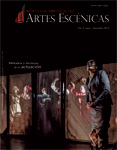Authors
Abstract
The objective of this article is to evaluate the experience of creation and evolution of the dance performance “Profetas do Movimento”, from its trajectory of academic research, and its scenic performances and products (book, catalogue, DVD and CD) within a period of 20 years. This work involves multiple scenic languages in a conception of art as a complete work, giving prioritity to the dance as a fundamental means of recreating the baroque life present in the set of 12 sculptures of the prophets by Aleijadinho. Laban’s theory of the analysis of movement was the methodology used in this work as well the levels of the intersemiotic translation applied to the art of dance proposed by Plaza, creating a new category: “The dance-mediation” which has put together artistic, aesthetic and religious aspects on the scene.
References
Domingues, D. (Org.), El arte en el siglo XXI: la humanización de las tecnologías. São Paulo: UNESP Editorial Fundación.
Guinsburg, J. (1968). Do Estudo da Oração. São Paulo: Perspective.
Laban, Rudolf. (1978). Domínio do Movimento.(Org. Lisa Ullmann, trad. Ana Maria Barros e Maria Sílvia Mourão). Summus.
Plaza, J. (1987). Traducción intersemiótica. São Paulo: Perspectiva.
Sachs, C. (1943). Historia universal de la Danza.Buenos Aires: Centurión.
Silva, S.M. (2001). Prophets em Movimento. São Paulo: Edusp/Imprensa Ofi cial.
________. (2006). Prophets em Movimento.Catalogue of production. Brasília: UnB/CDPDan.
Storniolo, I. (1986). Become familiar with Bible.São Paulo: Paulinas.

 PDF (Español)
PDF (Español)
 FLIP
FLIP









